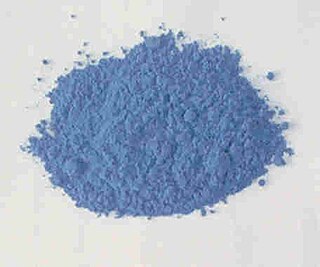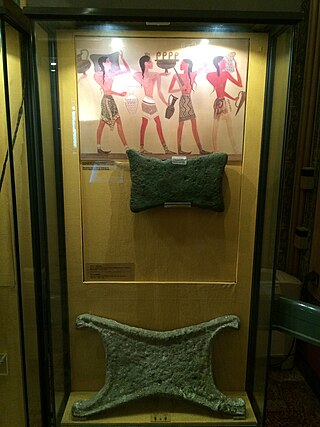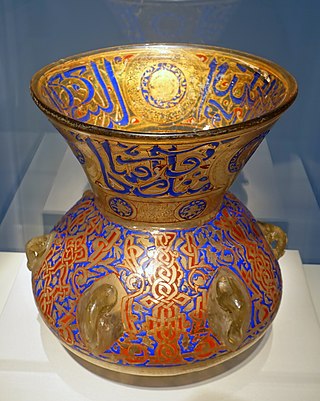
The Uluburun Shipwreck is a Late Bronze Age shipwreck dated to the late 14th century BC, discovered close to the east shore of Uluburun, Turkey, in the Mediterranean Sea. The shipwreck was discovered in the summer of 1982 by Mehmed Çakir, a local sponge diver from Yalıkavak, a village near Bodrum.

Egyptian blue, also known as calcium copper silicate (CaCuSi4O10 or CaOCuO(SiO2)4 (calcium copper tetrasilicate)) or cuprorivaite, is a pigment that was used in ancient Egypt for thousands of years. It is considered to be the first synthetic pigment. It was known to the Romans by the name caeruleum. After the Roman era, Egyptian blue fell from use and, thereafter, the manner of its creation was forgotten. In modern times, scientists have been able to analyze its chemistry and reconstruct how to make it.

Egyptian faience is a sintered-quartz ceramic material from Ancient Egypt. The sintering process "covered [the material] with a true vitreous coating" as the quartz underwent vitrification, creating a bright lustre of various colours "usually in a transparent blue or green isotropic glass". Its name in the Ancient Egyptian language was tjehenet, and modern archeological terms for it include sintered quartz, glazed frit, and glazed composition. Tjehenet is distinct from the crystalline pigment Egyptian blue, for which it has sometimes incorrectly been used as a synonym.

A frit is a ceramic composition that has been fused, quenched, and granulated. Frits form an important part of the batches used in compounding enamels and ceramic glazes; the purpose of this pre-fusion is to render any soluble and/or toxic components insoluble by causing them to combine with silica and other added oxides. However, not all glass that is fused and quenched in water is frit, as this method of cooling down very hot glass is also widely used in glass manufacture.

Anglo-Saxon glass has been found across England during archaeological excavations of both settlement and cemetery sites. Glass in the Anglo-Saxon period was used in the manufacture of a range of objects including vessels, beads, windows and was even used in jewellery. In the 5th century AD with the Roman departure from Britain, there were also considerable changes in the usage of glass. Excavation of Romano-British sites have revealed plentiful amounts of glass but, in contrast, the amount recovered from 5th century and later Anglo-Saxon sites is minuscule.

Roman glass objects have been recovered across the Roman Empire in domestic, industrial and funerary contexts. Glass was used primarily for the production of vessels, although mosaic tiles and window glass were also produced. Roman glass production developed from Hellenistic technical traditions, initially concentrating on the production of intensely coloured cast glass vessels.

Ancient Chinese glass refers to all types of glass manufactured in China prior to the Qing dynasty (1644–1911). In Chinese history, glass played a peripheral role in arts and crafts, when compared to ceramics and metal work. The limited archaeological distribution and use of glass objects are evidence of the rarity of the material. Literary sources date the first manufacture of glass to the 5th century AD. However, the earliest archaeological evidence for glass manufacture in China comes from the Warring States period.

Forest glass is late medieval glass produced in northwestern and central Europe from approximately 1000–1700 AD using wood ash and sand as the main raw materials and made in factories known as glasshouses in forest areas. It is characterized by a variety of greenish-yellow colors, the earlier products often being of crude design and poor quality, and was used mainly for everyday vessels and increasingly for ecclesiastical stained glass windows. Its composition and manufacture contrast sharply with Roman and pre-Roman glassmaking centered on the Mediterranean and contemporaneous Byzantine and Islamic glass making to the east.

Oxhide ingots are heavy (20–30 kg) metal slabs, usually of copper but sometimes of tin, produced and widely distributed during the Mediterranean Late Bronze Age (LBA). Their shape resembles the hide of an ox with a protruding handle in each of the ingot’s four corners. Early thought was that each ingot was equivalent to the value of one ox. However, the similarity in shape is simply a coincidence. The ingots' producers probably designed these protrusions to make the ingots easily transportable overland on the backs of pack animals. Complete or partial oxhide ingots have been discovered in Sardinia, Crete, Peloponnese, Cyprus, Cannatello in Sicily, Boğazköy in Turkey, Qantir in Egypt, and Sozopol in Bulgaria. Archaeologists have recovered many oxhide ingots from two shipwrecks off the coast of Turkey.

Hellenistic glass was glass produced during the Hellenistic period in the Mediterranean, Europe, western Asia and northern Africa. Glassmaking at this time was based on the technological traditions of the Classical antiquity and the Late Bronze Age, but was marked by transition from limited production of luxury objects made for the social elite to mass production of affordable glass vessels used by the broader public to satisfy everyday needs.
Robert Brill is an American archaeologist, best known for his work on the chemical analysis of ancient glass. Born in the US in 1929, Brill attended West Side High School in Newark, New Jersey, before going on to study for his B.S. degree at Upsala College. Having completed his Ph.D. in physical chemistry at Rutgers University in 1954, Brill returned to Upsala College to teach chemistry. In 1960, he joined the staff of the Corning Museum of Glass as their second research scientist.

Islamic glass is glass made in the Islamic world, especially in periods up to the 19th century. It built on pre-Islamic cultures in the Middle East, especially ancient Egyptian, Persian and Roman glass, and developed distinct styles, characterized by the introduction of new techniques and the reinterpreting of old traditions. It came under European influence by the end of the Middle Ages, with imports of Venetian glass documented by the late 15th century.

Medieval stained glass is the coloured and painted glass of medieval Europe from the 10th century to the 16th century. For much of this period stained glass windows were the major pictorial art form, particularly in northern France, Germany and England, where windows tended to be larger than in southern Europe. In some countries, such as Sweden and England, only a small number of original stained windows has survived to this day.
Ceramic petrography is a laboratory-based scientific archaeological technique that examines the mineralogical and microstructural composition of ceramics and other inorganic materials under the polarised light microscope in order to interpret aspects of the provenance and technology of artefacts.

The history of glass-making dates back to at least 3,600 years ago in Mesopotamia. However, most writers claim that they may have been producing copies of glass objects from Egypt. Other archaeological evidence suggests that the first true glass was made in coastal north Syria, Mesopotamia or Egypt. The earliest known glass objects, of the mid 2,000 BCE, were beads, perhaps initially created as the accidental by-products of metal-working (slags) or during the production of faience, a pre-glass vitreous material made by a process similar to glazing. Glass products remained a luxury until the disasters that overtook the late Bronze Age civilizations seemingly brought glass-making to a halt.

Due to various differences in cultural histories and environmental resources, West African nations developed glass traditions distinct from Egypt, North Africa and the rest of the world. The presence of glass in Sub-Saharan Africa mostly consists of the importation of glass beads shipped primarily from the Middle East and India as early as 200-300AD; later, from Portugal, the Netherlands, and Venice.

Gao-Saney, also spelled Gao-Sane, is an archaeological site near Gao in Mali. It was almost certainly the town known in historical accounts as Sarneh.
The Philippines is an archipelago located in Southeast Asia and consists of 7,641 islands. Prehistoric beads are among the most significant resources deriving from the human past. They are artifacts that inform individuals about archaeological records. Beads play a vital role in Asian lives, since they were utilized as human markers to indicate a territory; moreover, prehistoric beads were significant for ancestors as well as the people who occupied the identical territory. For instance, if beads are perished or destroyed, they can be recovered archaeologically due to their durability, which allows for the preservation of these resources. Furthermore, several of the decorative pieces and tools that they possess, as well as their culture, seem to reflect this maritime characteristic. Due to the fact that beads are transportable, compact in size, and appealing to the eye, they can essentially be discovered all over the world. Tools such as choppers made of shells as well as decorative pieces like shell beads are common in Southeast Asian archaeological records due to this characteristic. Various sites have been found to contain shell beads, including Sucgang Barrio in Bohol; Sibale Island, near Surigao; Suluan island, south of Samar; Lagen Island in Palawan; and Camotes Islands.

Khao Sam Kaeo is an archaeological site in Thailand's Chumphon province. It is located in Na Cha-ang subdistrict of Mueang Chumphon district, just north of the town of Chumphon, on the east coast of the Malay Peninsula, at the Kra Isthmus. Dated 400–100 BCE, Khao Sam Kaeo served as an extremely important port, as well as a crossroads for Asian connection and interaction, as it sat between the cultural regions of the South China Sea and the Bay of Bengal. There is evidence that material had come from the South China Sea, the Philippines, and Taiwan—all part of the maritime silk road of the time—proving the important technological and cultural connections between the site and these locations. This not only reveals the fact that people from across Asia ended up in Khao Sam Kaeo, but it also supports the idea that there was a transfer of ideas. When reviewing the material culture found at Khao Sam Kaeo, the transfer of ideas and trans-Asian connection becomes abundantly clear, especially when looking at ceramics, stone adzes, pendants, and jewelry. Data and research also point to the idea that foreign craftsmen stayed for long periods of time at Khao Sam Kaeo. Pottery and stone works made in an Indian technical style yet supposedly made locally support this idea. Collectively, evidence regarding material culture, raw materials, and biological data support the idea that the connections made at Khao Sam Kaeo were more than just trade and diffusion.
The Cardamom Mountains jar burials are a collection of twelve mortuary sites dating back to the late and post-Angkor period located in the Eastern region of Cambodia's Cardamom Mountains. In recent years, these sites have gained interest due to their unique wooden coffins and vast collections of large, ceramic jars that often hold multiple human skeletons. These remains encompass both adolescents and adults who are speculated to be from the highland populations that inhabited Cambodia's mountain range. Various types of grave goods have also been discovered inside and around these burial jars including glass beads, ceramics, and metal jewelry from maritime trade across South and Southeast Asia.

















